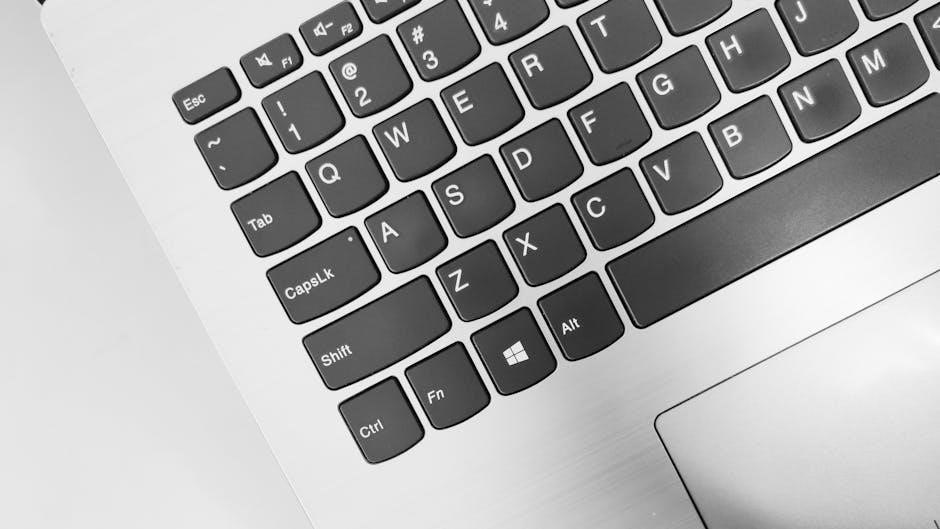Discover the essentials of RV lock programming, ensuring secure and convenient access. Learn to program key fobs, remotes, and keyless systems for enhanced RV security and seamless operation.
Importance of Proper Programming for RV Security
Proper programming of RV locks is crucial for ensuring robust security and preventing unauthorized access. Incorrect or incomplete programming can lead to security vulnerabilities, allowing potential breaches. By programming your RV locks correctly, you ensure that only authorized users can gain entry, safeguarding your property. Additionally, proper programming prevents system malfunctions, ensuring consistent and reliable performance. It also allows for customization, such as setting temporary codes or multiple user access, enhancing convenience without compromising security. Regular updates and correct setup further protect against potential threats, ensuring your RV remains secure and easy to manage. Proper programming is essential for maintaining peace of mind while protecting your investment.
Overview of RV Lock Systems and Their Features
RV lock systems offer advanced security solutions tailored for recreational vehicles. These systems typically include keyless entry, biometric authentication, and remote-controlled features, ensuring convenience and modern functionality. Many models come with programmable key fobs and keypads, allowing users to set unique passcodes and manage multiple access levels. Some systems integrate with smart home devices for seamless control via mobile apps. Additional features may include weather-resistant designs, tamper alerts, and low battery warnings. These locks are designed to withstand harsh outdoor conditions while providing durable and reliable performance; Their versatility and adaptability make them a popular choice for RV owners seeking to enhance security and accessibility.

Understanding RV Lock Types
RV locks vary, offering keyless, keypad, and biometric options. Each type provides unique security features, catering to different user preferences and needs for convenience and safety.
Keyless Entry Systems for RVs
Keyless entry systems offer a modern solution for RV security, eliminating the need for physical keys. These systems typically use a keypad or remote control to unlock doors. Installation involves mounting the keypad and connecting it to the lock mechanism. Programming a new code is straightforward, usually requiring entering the default code followed by the new one. Some systems also support remote fobs for added convenience. With features like temporary access codes and scheduled locking, keyless systems enhance security and flexibility. Regular maintenance, such as updating firmware, ensures optimal performance and protects against potential vulnerabilities.
Keypad Locks vs. Remote-Controlled Locks
Keypad locks and remote-controlled locks offer distinct advantages for RV security. Keypad locks provide touch-button access using a personal code, ideal for those who prefer not to carry a remote. They are also more resistant to signal interference. Remote-controlled locks, on the other hand, offer convenience with a simple button press, suitable for quick access. Both systems require programming, with keypad locks typically involving code entry and remotes needing synchronization with the lock. While keypads eliminate the need for physical keys, remotes add ease of use. Choosing between them depends on personal preference and specific security needs, ensuring reliable access to your RV.
Biometric and Smart Locks for RVs
Biometric and smart locks revolutionize RV security with advanced features. Biometric locks use fingerprint or facial recognition, eliminating the need for keys or codes. Smart locks integrate with smartphones, enabling remote access and real-time notifications. Programming these systems often involves syncing with apps or setting up biometric data. They offer enhanced security, convenience, and modern connectivity, making them ideal for tech-savvy RV owners. Ensure firmware updates are regular to maintain optimal performance and security.

Preparation for Programming
Ensure all tools and equipment are ready. Familiarize yourself with default codes and backup settings before starting the programming process to avoid data loss or system issues.
Gathering Necessary Tools and Equipment
To start programming your RV lock, you’ll need specific tools. Ensure you have the ignition key, the remote control or key fob, and the default code provided by the manufacturer. For some systems, a USB key or specialized software might be required. Additionally, a screwdriver may be needed to access the lock’s internal components. Having a backup power source, like extra batteries, is also essential to prevent interruptions. Make sure all components are compatible with your RV lock model. Always refer to the user manual for a detailed list of required tools to ensure smooth programming.
Understanding Default Codes and Settings
Default codes and settings are pre-programmed by manufacturers to ensure initial functionality. For most RV locks, the default passcode is often a simple sequence like “1234” or “0000.” These codes are designed for easy setup but should be changed for security. Understanding these defaults is crucial for programming, as they serve as the starting point for customization. Failure to modify them can compromise security. Always locate the default code in the user manual or on the manufacturer’s website. Be aware that some systems may require entering the default code to access programming modes. Never leave default settings unchanged to ensure your RV remains secure.
Backing Up Existing Settings Before Programming

Backing up existing settings before programming ensures you can restore your RV lock system to its previous state if errors occur. This step is crucial for maintaining functionality and security. Start by noting down all current codes, settings, and configurations. For keyless systems, record the default passcode and any user-defined codes. If your lock system uses remote controls, ensure all paired remotes are functioning correctly. Some systems allow exporting settings to a computer or mobile app, providing an additional layer of backup. Always consult the user manual for specific backup procedures. This precaution prevents data loss and ensures smooth recovery if programming goes awry.

Step-by-Step Programming Instructions
Master the process of programming your RV locks with clear, methodical guidance. Follow detailed steps to ensure secure and efficient setup for keyless entry, remotes, and key fobs.
Programming a Key Fob for RV Locks
To program a key fob for your RV locks, start by ensuring all doors are closed. Locate the switch at the back of the handle and turn it to the “ON” position. Next, press and hold the “LOCK” button on your remote until the handle acknowledges the command, typically with a sound or light. If your system requires it, insert the ignition key and press the specified buttons in sequence. Be sure to follow the exact steps for your RV lock system, as methods may vary by brand. If you encounter issues, consider consulting a video tutorial or professional assistance for guidance.
Resetting an RV Lock to Factory Settings
Resetting an RV lock to factory settings is useful for troubleshooting or starting fresh. Begin by turning the switch on the back of the lock handle to the “ON” position. Press and hold the “8” button while simultaneously pressing the “LOCK” button until the lock confirms the reset, typically with a sound or light. Release both buttons and repeat the process to ensure the reset is complete. This will restore the lock to its default settings, erasing all previously programmed codes and remotes. Be sure to reprogram your key fobs or remotes afterward. Always consult your lock’s manual or online guides for specific instructions.

Syncing Remote Controls with the RV Lock System
To sync a remote control with your RV lock, start by turning the switch on the back of the lock handle to the “ON” position. Press and hold the “LOCK” button on your remote until the lock system confirms the sync, usually indicated by a sound or light. Release the button and repeat the process for additional remotes. Ensure the lock handle acknowledges each remote by observing the confirmation signal. If syncing multiple remotes, complete the process for each one individually. Always refer to your lock’s manual for specific instructions, as slight variations may exist. Proper syncing ensures reliable operation and secure access to your RV.

Keypad Programming Instructions
Enter the default code, press the “8” button, then input your new code. Confirm by pressing “LOCK” to activate the updated passcode for secure keyless entry.
Setting Up a New Passcode for Keyless Entry
To set up a new passcode for your RV’s keyless entry system, start by entering the default code provided with your lock. This is typically “1234” or “0000”. Once entered, press and hold the “8” button on the keypad. Release it and immediately input your new desired passcode. Ensure the new code is between 4 to 6 digits for optimal security. After entering the new code, press the “LOCK” button to confirm. The system will respond with a confirmation signal, such as a beep or a flashing light, indicating the passcode has been successfully updated. This process ensures your RV remains secure with a personalized access code.
Programming Multiple User Codes for Shared Access
Programming multiple user codes allows secure shared access to your RV. Start by entering the default code, then press and hold the “8” button until the system beeps. Release and input the first new code, pressing “LOCK” to confirm. Repeat for additional codes, ensuring each is unique and 4-6 digits long. Most systems allow up to 10 user codes. After inputting all codes, press “LOCK” to finalize. The system will confirm with a beep or light flash. This feature is ideal for granting access to family or friends while maintaining control over entry permissions. Always test each code to ensure functionality and security.
Disabling or Deleting Unused Codes
To enhance security, regularly review and manage unused codes. Access the system by entering the master code, then press and hold the “LOCK” button until the indicator flashes. Input the code you wish to delete, followed by pressing “UNLOCK” to confirm. Some systems require a specific sequence, like pressing “8” after the master code. Once deleted, the code will no longer grant access. This prevents unauthorized use and reduces potential vulnerabilities. Always refer to your RV lock’s manual for precise instructions, as methods may vary. Keeping only active codes ensures maximum security and peace of mind for your RV’s access system.

Troubleshooting Common Issues
Addressing connectivity problems between remotes and locks often involves resetting the system or replacing batteries. Ensure all components are powered and synchronized correctly for smooth operation.
Resolving Connectivity Problems Between Remote and Lock
To resolve connectivity issues between your remote and lock, start by ensuring both devices have fresh batteries. If problems persist, reset the remote by holding the lock button until the LED flashes. Next, synchronize the remote with the lock system by pressing and holding the lock button on the remote while turning the ignition key to the “ON” position. If these steps fail, check for interference from other electronic devices or verify that the remote is correctly programmed to your RV’s lock system. Repeating these steps may be necessary to establish a stable connection.
Fixing a Lock That Doesn’t Respond to Commands
If your RV lock isn’t responding to commands, start by checking the battery levels in both the remote and the lock system. Replace batteries if necessary. Next, reset the lock by pressing and holding the lock button on the remote until the LED light flashes. If the issue persists, ensure the lock is properly synchronized with the remote by following the manufacturer’s pairing instructions. Additionally, inspect the lock for physical obstructions or dirt that may interfere with its operation. If none of these steps resolve the issue, consider consulting the user manual or contacting a professional for further assistance to restore functionality.
Addressing Battery Issues in Key Fobs and Remotes
Battery issues in key fobs and remotes are common but easily resolved. Start by checking the battery level, as weak or dead batteries often cause malfunction. Replace the batteries with the correct type specified in the manual. Ensure the battery compartment is clean and free of corrosion, which can disrupt connectivity. If the issue persists, test the remote with a fresh set of batteries to confirm proper function. For key fobs, try resetting the device by pressing and holding the lock button until the LED light flashes. Regularly inspecting and maintaining your remote’s battery will prevent future issues and ensure reliable performance.

Advanced Programming Features
Explore advanced RV lock programming features to enhance security and convenience. Discover how to set temporary codes, scheduled timers, and integrate with smart home systems seamlessly.
Setting Up Temporary Access Codes
Temporary access codes offer flexibility for short-term users while maintaining security. Program codes for visitors or service providers with specific timeframes. Use the RVLock keypad to create codes that expire automatically, ensuring unauthorized access is prevented. Follow the manufacturer’s instructions to input the start and end times, then save the settings. This feature is ideal for granting access to rental guests or maintenance personnel without compromising long-term security. Ensure codes are unique and communicate them securely to avoid misuse. Regularly review and update temporary codes to maintain optimal RV security.
Programming Scheduled Lock/Unlock Timers
Enhance convenience and security by programming scheduled lock/unlock timers for your RV. Use the RVLock system to set specific times for automatic locking and unlocking. Access the programming menu via the keypad or remote, input the desired times, and save the settings. This feature is perfect for routine schedules or seasonal use. Ensure timers align with your lifestyle for seamless access. Regularly review and update schedules to maintain security. Scheduled timers reduce the need for manual operations, offering peace of mind and efficient RV management. Follow the manufacturer’s instructions to avoid errors during setup. This feature complements temporary codes and smart integrations for advanced security solutions.
Integrating RV Locks with Smart Home Systems
Seamlessly integrate your RV locks with smart home systems for enhanced control and convenience. Using platforms like RVLock, connect your locks to smart hubs or voice assistants. Program custom voice commands or routines to lock/unlock doors, monitor access, and receive notifications. Ensure compatibility by checking supported systems and following integration guides. This setup allows remote monitoring and control via smartphone apps, ideal for tech-savvy RVers. Integration enhances security by enabling real-time alerts and centralized management. Regularly update firmware and ensure stable internet connections for reliable performance. This advanced feature transforms your RV into a smart, connected space, aligning with modern smart home capabilities for a futuristic experience.

Maintenance and Security Tips
Regularly inspect and lubricate RV locks to ensure smooth operation. Update firmware for enhanced security features and monitor access logs to prevent unauthorized entry, ensuring long-term reliability;
Regular Maintenance for RV Locks
Regular maintenance is crucial for ensuring the longevity and functionality of RV locks. Start by inspecting all locking mechanisms for signs of wear or damage. Clean the locks periodically to remove dirt and debris, which can hinder smooth operation. Lubricate hinges and moving parts with a silicone-based spray to prevent rust and friction. Additionally, check the alignment of doors and locks to ensure proper sealing and locking. Replace worn-out keys or key fobs promptly to avoid security breaches. Finally, test all locks and remote controls regularly to identify and address any issues before they escalate. Consistent upkeep ensures reliable security and convenience for your RV.
Best Practices for Securing Your RV
To ensure maximum security for your RV, always use strong, unique passcodes for keyless entry systems and avoid sharing them unnecessarily. Keep your RV locked, even when parked in secure areas, and consider investing in a high-quality hitch lock or wheel chock for added protection. Regularly inspect your locks for signs of tampering or damage and address any issues promptly. Use a secure location to store spare keys and never leave remote controls or key fobs in plain sight. Additionally, consider installing a GPS tracking device and alarm system for enhanced security. Consistent vigilance and proactive measures will help safeguard your RV from unauthorized access and potential theft.
Updating Firmware for Enhanced Security
Updating your RV lock’s firmware is crucial for maintaining optimal security and functionality. Regular firmware updates patch vulnerabilities, enhance performance, and add new features. To update, visit the manufacturer’s website, download the latest firmware, and transfer it to a USB drive. Insert the USB into the lock’s programming port and follow on-screen instructions. Ensure the device is fully charged or connected to a power source during the update. Avoid interrupting the process to prevent system corruption. After completion, test the lock to ensure all features work correctly. Keeping your firmware up-to-date is essential for safeguarding your RV against potential security breaches and ensuring reliable operation.
By following these steps, you’ve successfully programmed your RV locks, ensuring enhanced security and convenient access. Your RV is now safer and more accessible than ever.
Final Checklist for Successful RV Lock Programming
Ensure all steps are completed: program key fobs, test lock functionality, update user codes, verify battery levels, and review system settings. Confirm seamless operation and security.
Resources for Further Assistance
Explore official RVLock guides, instructional videos, and forums for troubleshooting. Visit www.rvlock.com for detailed manuals, customer support, and additional remotes. Watch tutorials on YouTube for visual guidance.
